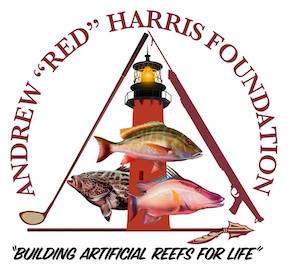Jamel Lanee from WPTV Channel 5 followed up with me Sunday night July 7, 2014 and I reluctantly agreed to speak to the media for the first time since the accident. My condition was that the segment was to focus on the foundation we had decided to form.
The segment was to run on the 6 PM news on Monday July 8 and all I had to give those that wanted to be involved was my email. I called Andrew Nicoll from Lighthouse SEO and Design at 8 AM Monday and asked if we could get a website going in time for the 6 PM news. He worked on it all day and got it done. Jamel showed the website on her laptop during the segment, we had over 1,500 visits to the new site and we have been building the foundation ever since.
Andrew’s family and friends came together and raised $150,000 between August and November 2014 to get the Andrew “Red” Harris Foundation established, even though it was too early to know what kind of artificial reefs we would build (ships? bridge debris? something else?).
We have a group of 70+ volunteers that have worked on the golf tournament, silent auction, tennis tournament, 3 Natives fundraiser, seeking grants, accounting, communications, festivals participation, artificial reef consulting, module construction and spreading the word about our mission and much more.
We investigated creating a reef by sinking a retired ship and considered many options. But making a reef with a ship requires a 1500 foot diameter site that is clear of any live reef and that’s hard to come by in 80-100 foot deep water off northern Palm Beach County.
We investigated building reefs with construction “materials of opportunity” (bridge debris and culverts), but that approach requires 3+ acres of waterfront property to stage the materials for deployment. that’s hard to come by in Palm Beach County. And after you dump thousands of tons of debris in the ocean to make a reef…it looks like a giant pile of debris.
The third approach to building artificial reefs is to construct concrete modules. “Reef Balls” are the most common concrete artificial reef modules, but they are not ideal for our location and are rarely used on Florida’s east coast. “Reef Pyramids” are another common option.
Our “elevator speech” description of our work is that we are “raising money to build huge concrete reef modules that we will donate to the Palm Beach County Artificial Reef Department for deployment on sites that are already permitted for artificial reef construction by the Army Corps of Engineers”.
In November 2014, Chris O’Hare, a talented architectural cement manufacturer called me after seeing an article in the Palm Beach Post. Chris wanted to donate a life-sized sculpture of Andrew as a memorial. I met with Chris and we formed a partnership to design and manufacture huge and unique concrete reef modules which will look like Bahamian coral heads. We deployed 40 modules that Chris made for us in August, 2015.
We followed up in August 2016 with a 100 module deployment comprised of 50 pyramids, 35 blown-cement “Coral head” structures and 15 concrete block structures 1.5 miles northeast of the Jupiter inlet.
In November, 2016 we deployed 15 beautiful “Lagoon Coral Head” modules on the Phil Foster Park Snorkel Trail at the Blue Heron Bridge. In 2017 we will deploy between 100 and 200 more modules on the August, 2016 site.
The community’s generosity in volunteering and funding the foundation has allowed the foundation to get established. Many large foundations and public entities have provided funding and we are well on our way to reaching the Foundation’s goals.
